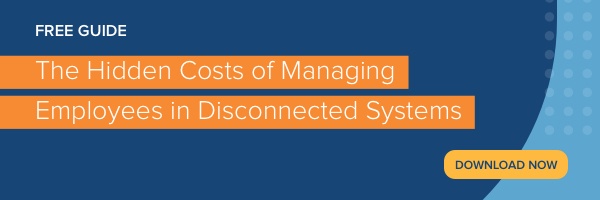In an area as broad as HR, it’s easy to get pulled in several different directions. When running a busy HR department, you need to meet the expectations of employees and senior leaders, while also making sure you satisfy compliance requirements for hiring and employee management.When you know how to streamline HR processes for greater efficiency, you can get more done. As a result, you’ll have more time to support your workforce and deliver a better employee experience.
The Benefits of Streamlining HR Processes
By streamlining HR processes through automation and process improvement, you can save your organization time and money. McKinsey research found that more than half (56 percent) of traditional HR activities can be automated. The research also cited an example of an organization that automated key HR processes and realized a 66 percent reduction in processing time and improved compliance. The organization was also able to move four full-time employees to more value-added work.
Inefficient processes force you to take longer to complete routine tasks. But when you streamline HR processes, you can avoid the pitfalls of manual and inefficient workflows, such as:
- Reduced reporting capability
- Inconsistent reporting
- Errors in payroll and benefits
- Compliance mishaps
By using tools and resources designed to improve the efficiency of HR processes, you can increase your productivity and manage your workforce more effectively. Instead of lamenting the limitations of your HR technology, you can leverage it to help you get more done.
Workforce management software offers the following benefits:
- Fewer manual (and often redundant) processes
- Less time going back and forth between poorly integrated HR systems
- Ease of storing, accessing, and reporting on employee data
- Better data-driven decision-making
How to Streamline HR Processes
In today’s fast-paced work environment, you and your employees can benefit from improved efficiency. Take these five time-saving actions to streamline your HR workflows:
1. Review Existing Processes
When looking for possible areas to make improvements, it can be challenging to know where to start. By reviewing each area of the employee lifecycle journey, you can identify new opportunities to automate and create process efficiencies. Review your processes in the following areas:
- Recruitment and applicant tracking
- Onboarding
- Payroll and benefits
- Time and attendance
- Performance management
- Training
- Offboarding
As you look for ways to improve the efficiency of HR processes from hiring to offboarding, you don’t have to address each process with its own system. Instead of managing your workforce in siloes, you can automate HR processes with the help of an all-in-one human capital management (HCM) solution.
2. Replace Paper with Cloud-Based Tools
Paper processes make it harder to view and analyze workforce data in real time. When you reduce the paper and move to the cloud, you have more recruiting and employee information at your fingertips and can make better-informed decisions. For example, instead of tracking paper resumes and candidate emails, you can use a cloud-based HR system with applicant tracking capability. You can see all candidates for each position, as well as candidate sources, interview notes, and where each candidate stands in the hiring process.
3. Integrate Payroll with HR Services
Managing your payroll separately from other employee management activities increases double entries and the chance of errors. For example, when you add employees or make a salary adjustment, you have to make those changes in your HR and payroll systems, which can lead to a mismatch in employee data.
Conversely, when you integrate payroll with HR activities, such as time and attendance, benefits administration, and headcount reporting, you have more consistency and fewer chances of an erroneous paycheck. Instead of having to constantly reconcile payroll data with information in other systems, you can integrate them with one time-saving platform.
4. Add Employee Self-Service
Being responsive to employee requests is critical, but instead of having someone from the HR team spend time answering routine questions or providing employees with forms, you can accomplish all of that with employee self-service. Self-service frees up your HR department to focus on other work, while giving employees access to the information they need to understand pay, benefits, and HR policies.
Self-service empowers employees to enter changes, such as a new address or updated direct deposit instructions. It also gives employees access to the following information:
- Payroll documents, such as pay stubs and W-2 forms
- Benefit plan summaries and coverage details
- Time and attendance tracking, including requests and accruals
5. Track Workforce Metrics
Tracking key metrics helps you identify areas for improvement. The following are just a few examples of workforce metrics that can reveal inefficiencies or opportunities for cost savings:
- Time to hire
- Turnover rate
- Payroll expense
- Healthcare cost per employee
As you track these HR metrics over time, you will be able to identify a range of time- and money-saving HR automation tools to enable your HR department to do more.
Leverage Technology to Streamline HR Processes
Taking steps to streamline HR processes helps you spend your time wisely. By reducing manual workflows, integrating core HR processes, and offering employee self-service, you can increase your productivity and have more time to support the workforce.
Increasing your efficiency doesn’t require adding more and more HR systems. When you use an all-in-one integrated HR platform to manage your workforce, you avoid the pitfalls of working with multiple HR systems.
For more tips on getting the most from your HR technology, read our free e-book, The Hidden Costs of Managing Employees in Disconnected Systems.

